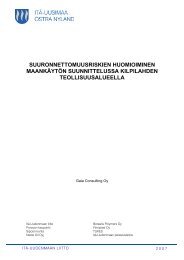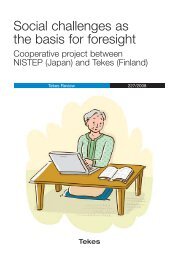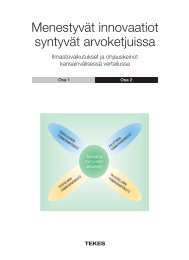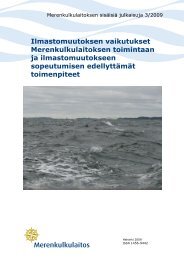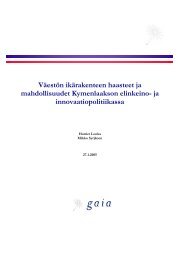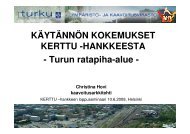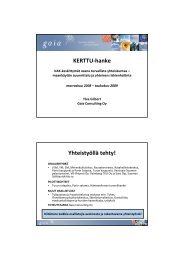Climate Risk Management in Finnish Development Cooperation - Gaia
Climate Risk Management in Finnish Development Cooperation - Gaia
Climate Risk Management in Finnish Development Cooperation - Gaia
You also want an ePaper? Increase the reach of your titles
YUMPU automatically turns print PDFs into web optimized ePapers that Google loves.
Some models also <strong>in</strong>dicate an <strong>in</strong>crease <strong>in</strong> the proportion of total ra<strong>in</strong>fall that falls <strong>in</strong> ‘heavy’<br />
events, with annual changes rang<strong>in</strong>g from -1 to +18%. The largest <strong>in</strong>creases are projected for<br />
the periods July-September and October-December. These models are broadly consistent <strong>in</strong><br />
<strong>in</strong>dicat<strong>in</strong>g <strong>in</strong>creases <strong>in</strong> the magnitude of 1- and 5-day ra<strong>in</strong>fall maxima. The annual <strong>in</strong>creases<br />
arise largely due to <strong>in</strong>creases <strong>in</strong> October-December. The changes <strong>in</strong> maxima <strong>in</strong> 1-day events<br />
<strong>in</strong> October-December range from 0 to +29mm and -4 to +40mm <strong>in</strong> 5-day events. 35 The<br />
overall uncerta<strong>in</strong>ty about the future precipitation patterns, changes <strong>in</strong> both amount and<br />
tim<strong>in</strong>g of ra<strong>in</strong>fall <strong>in</strong> different parts of Ethiopia will exacerbate the already considerable<br />
challenges with high ra<strong>in</strong>fall variability.<br />
Tak<strong>in</strong>g note of all these projected trends, <strong>in</strong>clud<strong>in</strong>g a potential <strong>in</strong>crease <strong>in</strong> climate extremes,<br />
Ethiopia will have to f<strong>in</strong>d ways to adapt to a highly unpredictable climate. Some recent<br />
studies of river bas<strong>in</strong>s <strong>in</strong> Eastern Africa, <strong>in</strong>clud<strong>in</strong>g Ethiopia show a tendency for higher flows<br />
due to higher ra<strong>in</strong>fall, i.e. <strong>in</strong>creases <strong>in</strong> ra<strong>in</strong>fall big enough to offset greater losses due to<br />
evaporation. 36 While flood characteristic have not been well studied it is very likely that<br />
flood frequency and magnitude will <strong>in</strong>crease under such conditions.<br />
While temperature <strong>in</strong>crease can be projected with a rather high confidence many of the<br />
other climatic parameters rema<strong>in</strong> uncerta<strong>in</strong>, with considerable regional and seasonal<br />
variations to be expected for Ethiopia. The national response to the already experienced<br />
changes, as well as the longer-term adaptation strategy must be able to propose a wide set<br />
of solid climate adaptation measures, that can cope with a wide range of climatic patterns<br />
and flexibly stepped-up where and whenever required.<br />
35 UNDP <strong>Climate</strong> Change Country Profiles, Ethiopia (2008).<br />
36 Conway, D et al (2007).<br />
17



